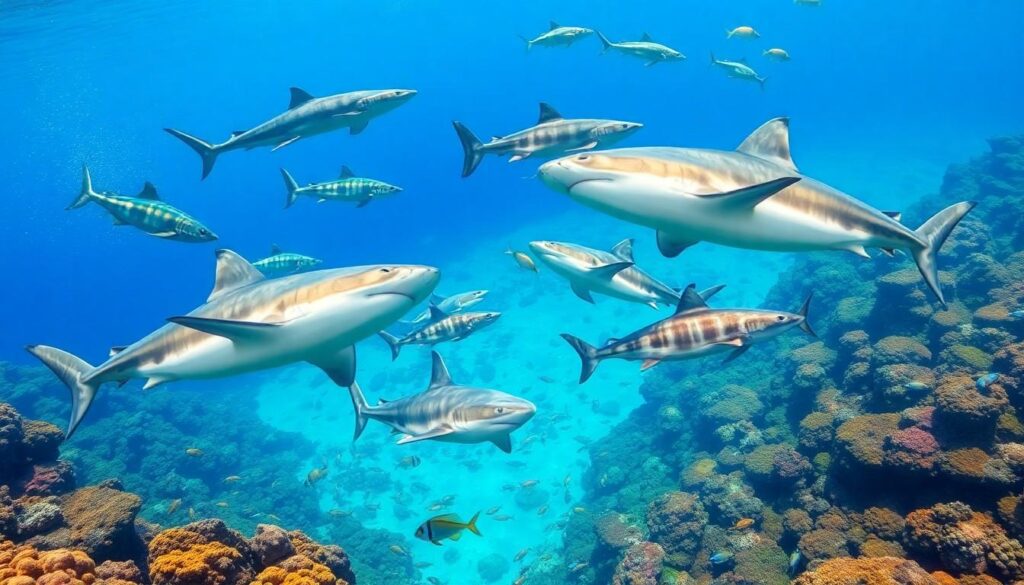The ocean is home to a staggering variety of life, and sharks are among its most fascinating residents. With over 500 species swimming through our seas, estimating their total population is no easy task. Researchers believe there are millions of sharks in the ocean, but exact numbers vary widely depending on the species and their habitats.
Understanding how many sharks inhabit our waters is crucial for conservation efforts. Sharks play a vital role in maintaining the balance of marine ecosystems. As you dive into this topic, you’ll uncover insights into shark populations, their importance, and the challenges they face in today’s changing world.
Understanding Shark Populations
Shark populations represent a critical aspect of marine ecosystems. Researchers categorize over 500 species of sharks, which implies significant diversity in habitat and behavior. Estimating the total number of sharks in the ocean proves challenging due to the wide range of environments and elusive nature of these creatures.
Factors Affecting Shark Populations
Several factors influence shark populations, including:
- Habitat loss: Coastal development, pollution, and climate change alter shark habitats, leading to population declines.
- Overfishing: Commercial fisheries target various shark species, impacting their numbers significantly. Many sharks face unsustainable fishing rates.
- Bycatch: Non-target species caught in fishing gear also include sharks, complicating population recovery efforts.
Estimated Shark Populations by Species
While precise population numbers remain elusive, estimations suggest millions of sharks across the globe. The following table illustrates estimated populations for key species:
| Shark Species | Estimated Population | Habitat Type |
|---|---|---|
| Great White Shark | 3,500 – 4,000 | Coastal waters |
| Hammerhead Shark | 200,000 – 300,000 | Oceanic waters |
| Tiger Shark | 20,000 – 30,000 | Tropical environments |
| Whale Shark | Fewer than 10,000 | Tropical waters |
| Blue Shark | 10 million | Offshore |
Importance of Shark Populations
Understanding the dynamics of shark populations aids conservation efforts. Sharks play pivotal roles in maintaining healthy marine ecosystems by regulating prey populations. A decrease in sharks can lead to overpopulation of certain fish species, which can damage coral reefs and other habitats.
Challenges in Population Estimation
Researchers face challenges in estimating shark populations accurately. Many species inhabit deep or remote areas, making data collection difficult. Increased surveillance and advanced technologies, such as satellite tagging, offer potential solutions, enhancing monitoring capabilities moving forward.
Shark populations reflect ecological health, indicating potential problems within marine environments. Your awareness and understanding of these populations contributes significantly to ongoing conservation efforts.
Factors Influencing Shark Numbers
Various factors significantly influence shark populations in the ocean. Understanding these aspects is crucial for effective conservation strategies.
Overfishing
Overfishing severely impacts shark numbers. Many sharks are targeted for their fins, meat, and liver oil. With up to 100 million sharks killed annually due to fishing activities, species such as the Great White and Hammerhead face serious population declines. The chart below illustrates the estimated catch rates of sharks by type.
| Shark Species | Estimated Annual Catch |
|---|---|
| Great White Shark | 10,000 – 15,000 |
| Hammerhead Shark | 20,000 – 30,000 |
| Blue Shark | 4 million |
Overfishing disrupts their breeding cycles and diminishes juvenile populations, hindering recovery efforts. Sustainable fishing practices and strict regulations are essential to protect these vital marine predators.
Habitat Loss
Habitat loss poses another critical threat to shark populations. Coastal development, pollution, and climate change lead to the degradation of vital habitats like coral reefs and estuaries. Loss of these ecosystems affects prey availability while displacing shark species. The table below highlights key habitat loss impacts on shark populations.
| Impact | Description |
|---|---|
| Coral Bleaching | Reduces nursery habitats for various shark species. |
| Pollution | Contaminates waters, affecting shark health. |
| Coastal Development | Destroys essential breeding grounds. |
Mitigation measures, such as establishing marine protected areas, help preserve crucial habitats, promoting healthier shark populations.
Estimating Shark Population Sizes
Estimating shark population sizes involves various methods and faces significant challenges. Understanding these aspects is crucial for effective conservation strategies.
Methods of Population Assessment
Several methods assess shark populations, including:
| Method | Description |
|---|---|
| Visual Surveys | Use divers or remote-operated vehicles to count sharks in specific areas. |
| Tagging Programs | Involve attaching tags to individual sharks to track movements and estimate population size. |
| Environmental DNA (eDNA) | Collects genetic material from water samples to identify shark species presence. |
| Catch Data | Analyzes data from commercial fisheries to infer population trends. |
Research typically combines these methods for comprehensive insights. These approaches enhance understanding of species distribution and abundance.
Challenges in Data Collection
Data collection on sharks faces various challenges:
| Challenge | Impact |
|---|---|
| Geographic Accessibility | Remote habitats hinder data gathering efforts. |
| Behavioral Patterns | Sharks’ migratory nature complicates consistent monitoring. |
| Limited Funding | Insufficient financial resources restrict research scope and technology use. |
| Reporting Inconsistency | Inaccurate or incomplete reporting by fisheries skews data. |
Such challenges affect the accuracy of population estimates. Improved funding and technological innovations like satellite tracking may help address these issues.
Impact of Shark Populations on Marine Ecosystems
Shark populations significantly influence marine ecosystems, affecting biodiversity, species dynamics, and overall ocean health. As apex predators, sharks maintain the population balance of species below them in the food chain. This regulation prevents overpopulation of certain fish and maintains coral reef ecosystems, which rely on various species for nutrient cycling and habitat stability.
Role in Ecosystem Dynamics
- Prey Regulation: Sharks help regulate the populations of smaller fish and invertebrates. Healthy shark populations ensure the control of these species, allowing for a balanced ecosystem.
- Biodiversity Maintenance: The presence of sharks promotes biodiversity. Higher biodiversity leads to more resilient ecosystems, better able to withstand environmental stressors.
Declines and Their Consequences
Shark population declines cause significant ecological disturbances. The absence of sharks can trigger a phenomenon known as a “trophic cascade,” where the removal of top predators leads to dramatic shifts in species composition and ecosystem function. For example:
| Impact | Description |
|---|---|
| Increased Prey Populations | Without sharks, prey species can multiply unchecked, leading to resource depletion. |
| Loss of Biodiversity | Species reliant on healthy prey populations may decline, disrupting the entire ecosystem. |
| Habitat Degradation | Overpopulated herbivorous fish can damage vital habitats like coral reefs. |
Threatened Species and Ecosystem Health
Specific shark species face greater threats and their decline is particularly alarming. The Great White Shark and the Hammerhead Shark play critical roles in marine environments. Their declining numbers, primarily due to overfishing and habitat loss, complicate the health of marine ecosystems.
Conservation Implications
Conservation efforts must focus on protecting sharks to sustain marine ecosystem health. Initiatives such as establishing marine protected areas help safeguard these apex predators and their habitats, fostering overall ecosystem resilience.
By understanding the critical role of shark populations, you contribute to ongoing discussions on marine conservation, emphasizing the need for immediate actions to protect these vital species and the health of the oceans.
Conclusion
Understanding the number of sharks in the ocean is crucial for their conservation and the health of marine ecosystems. With millions of sharks swimming in our waters their presence plays a vital role in maintaining ecological balance.
As you dive deeper into the world of sharks you’ll see how their populations are threatened by overfishing habitat loss and climate change. Supporting conservation efforts and raising awareness can help protect these magnificent creatures.
Every action counts when it comes to preserving shark populations. By advocating for sustainable practices and marine protected areas you can contribute to the future of sharks and the overall health of our oceans.
Frequently Asked Questions
How many shark species are there?
There are over 500 species of sharks in the ocean. Each species has unique characteristics and behaviors that contribute to the overall diversity of marine life.
Why is it difficult to estimate shark populations?
Estimating shark populations is challenging due to their diverse habitats, migratory behavior, and limited data collection methods. Factors like climate change and overfishing also complicate accurate assessments.
What factors threaten shark populations?
Shark populations face threats from habitat loss due to coastal development, overfishing, bycatch from commercial fishing, and pollution, all of which negatively impact their ecosystems.
What is the estimated global shark population?
While precise numbers are unclear, researchers estimate that there are millions of sharks globally. Some key species’ populations include about 3,500-4,000 Great White Sharks and 10 million Blue Sharks.
How do researchers estimate shark populations?
Researchers use methods like visual surveys, tagging programs, environmental DNA (eDNA) analysis, and analyzing catch data from fisheries to estimate shark populations and monitor their health.
Why are sharks important to marine ecosystems?
Sharks are apex predators that help regulate the populations of smaller fish and invertebrates. Their presence is crucial for maintaining biodiversity and overall ocean health.
How does overfishing impact shark populations?
Overfishing leads to the decline of shark populations, with estimates suggesting up to 100 million sharks are killed annually. Targeted fishing for their fins, meat, and liver oil severely threatens certain species.
What conservation measures can help sharks?
Establishing marine protected areas, improving fishing regulations, and promoting public awareness about shark conservation can significantly help in preserving shark populations and their habitats.


